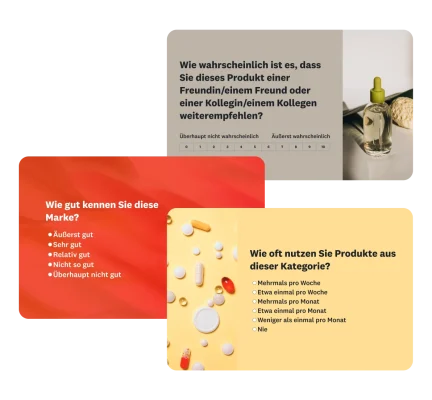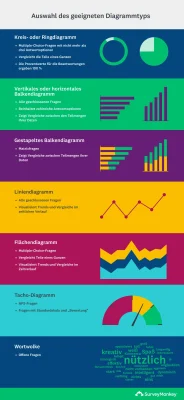Marktforschung: Was sie ist, wie Sie sie durchführen und Beispiele
Erfahren Sie, wie Sie Marktforschung betreiben, um neue Märkte zu erschließen, Kundinnen und Kunden zufriedenzustellen und neue Produkte auf den Markt zu bringen.

Marktforschung verschafft Unternehmen umfassende, datengestützte Erkenntnisse über Kundinnen und Kunden, Trends und Mitbewerber. Mithilfe von Marktforschung können Unternehmen die genauen Daten erhalten, die sie benötigen, um neue Märkte zu erschließen, ihren Kundenkreis zufriedenzustellen und neue Produkte erfolgreich auf den Markt zu bringen.
Das ist besonders wichtig, da mehr als 70 % aller neu eingeführten Produkte für den täglichen Gebrauch nach ihrer Einführung scheitern. Eine frühzeitige Marktforschung reduziert dieses Risiko erheblich und maximiert den Erfolg, weil Sie damit Ihre Geschäftsstrategie auf die Kundenbedürfnisse abstimmen.
Erfolgreiche Geschäftsabläufe beginnen mit effektiver Marktforschung.
Was ist Marktforschung?
Marktforschung ist der Prozess der Erhebung von Daten über Verbraucherverhalten, Vorlieben, Kategorietrends und Wettbewerbsinformationen.
Unternehmen führen Marktforschung für gewöhnlich durch, um die Produktentwicklung und die Markteinführungsstrategie zu optimieren und letztlich das Geschäftswachstum anzukurbeln. Die Ergebnisse der Marktforschung bieten einen klaren Weg, um Kundenanforderungen zu erfüllen, Gewinne zu steigern und Produkte auf den Markt zu bringen.
Methoden der Marktforschung
Es wäre nachlässig, Marktforschung als etwas Einheitliches zu betrachten. Tatsächlich ist Marktforschung ein weit gefasster Begriff, der mehrere Arten von Forschung umfasst, sodass Sie eine Vielzahl von Daten und Belegen erfassen können, um fundierte Geschäftsentscheidungen zu treffen.
- Primärforschung oder Erstforschung findet statt, wenn Sie ursprüngliche Daten erheben, die eine bestimmte Forschungsfrage beantworten.
- Sekundärforschung findet statt, wenn Sie vorhandene Daten, die von anderen veröffentlicht wurden, analysieren, um Ihre Frage zu beantworten.
Das Verständnis beider Arten von Marktforschung, der Forschungsmethoden und ihrer jeweiligen Anwendungsfälle kann Ihnen dabei helfen, ein Marktforschungsdesign zu erstellen, das Ihre geschäftliche Fragestellung effektiv behandelt.
Primäre Marktforschung
Primärforschung ist sinnvoll, wenn ein Unternehmen wahrscheinlich keine frei verfügbaren Daten zu einer gestellten Forschungsfrage finden wird. Das kann insbesondere dann der Fall sein, wenn ein Unternehmen seine eigenen Produkte und Services untersuchen möchte.
Im Folgenden werden einige Methoden genannt, die in der Marktforschung eingesetzt werden:
- Umfragen sind eine quantitative Methode zur Erhebung von Informationen aus einer großen Gruppe von Befragten durch standardisierte Fragen. Sie helfen Unternehmen dabei, Kundenpräferenzen, Kaufverhalten, Zufriedenheitsgrade und Marktnachfrage zu verstehen. Umfragen können über offene Fragen auch qualitative Daten erfassen.
- Interviews sind Einzelgespräche, die Erkenntnisse über die individuellen Motivationen, Wahrnehmungen und Entscheidungsprozesse von Kundinnen und Kunden liefern. Tiefgehende Interviews ermöglichen eine intensivere Auseinandersetzung mit komplexen Themen, die in Gruppensituationen möglicherweise nicht zur Sprache kommen.
- Fokusgruppen sind moderierte Diskussionen mit einer kleinen Gruppe von Zielkunden, die kollektive Einstellungen, Meinungen und Reaktionen auf Geschäftsideen, Produkte, Services oder Marketingstrategien ans Licht bringen.
- Online-Marktforschung, wie Webanalysen, Social Media Listening und Marktforschungsumfragen, erfasst Echtzeitdaten über Kundenverhalten, Markttrends und Wettbewerbspositionierung.
- Produkttests ermöglichen es potenziellen Kundinnen und Kunden, ein Produkt unter kontrollierten oder realen Bedingungen zu verwenden. Produkttests helfen dabei, Probleme hinsichtlich der Benutzerfreundlichkeit zu identifizieren, die Kundenzufriedenheit zu messen und das Angebot vor der vollständigen Markteinführung zu optimieren.
Sekundäre Marktforschung
Sekundäre Marktforschung ist nützlich, wenn eine allgemeine Untersuchung zu einem bereits erforschten Thema durchgeführt werden soll. Für allgemeine Fragestellungen wurden in der Regel bereits Antworten veröffentlicht.
Zu den Methoden der sekundären Marktforschung gehören:
- Branchenberichte werden von Forschungsunternehmen, Handelsverbänden oder Beratungsfirmen erstellt. Diese Berichte liefern detaillierte Erkenntnisse über Marktgröße, Wachstumstrends, wichtige Akteure und Zukunftsaussichten. Anhand dieser Berichte können Unternehmen ihre Leistung bewerten, neue Chancen erkennen und fundierte strategische Entscheidungen treffen.
- Die Wettbewerbsanalyse ist eine systematische Bewertung direkter und indirekter Mitbewerber, um deren Stärken und Schwächen zu verstehen. Diese Analyse ermöglicht es Unternehmen, Marktlücken aufzudecken, sich effektiver zu differenzieren und Wettbewerbsmaßnahmen zu antizipieren.
- Zu den Veröffentlichungen der Regierung gehören Wirtschaftskennzahlen, demografische Statistiken, Handelsdaten und behördliche Vorschriften. Diese Veröffentlichungen bieten zuverlässige, oft kostenlose Ressourcen, um Marktannahmen zu validieren und die Einhaltung gesetzlicher und branchenüblicher Standards sicherzustellen.
So führen Sie Marktforschung durch: eine Schritt-für-Schritt-Anleitung
Marktforschung ist ein nuancierter Prozess, der Weitsicht und eine gewisse Vorausplanung erfordert. Wenn Sie die Schritte richtig angehen, können Sie erfolgreiche Initiativen starten, Erkenntnisse erfassen und Ihren Daten umsetzbare Maßnahmen für Ihr Unternehmen entlocken.
Folgende Punkte sollten Sie bei der Durchführung von Marktforschung beachten.
Schritt 1: Legen Sie die Forschungsziele fest
Die Forschungsfrage und die daraus resultierende Zielsetzung geben Ihrer Forschung eine Richtung und legen alles fest, von der Datenerhebung bis hin zur Analysemethode.
Die geschäftliche Fragestellung ist eine kurze Zusammenfassung des Problems, das Sie lösen möchten, und gibt den Kontext für Ihr Unternehmen an. Unter die geschäftliche Fragestellung fallen übergeordnete Ziele oder Herausforderungen, die in direktem Zusammenhang mit Geschäftszielen stehen. Ein Beispiel: „Warum sind die Umsätze rückläufig?“
Das Forschungsziel ist ein Überblick über die genauen Fakten oder Kennzahlen, die Sie durch Ihre Forschung ermitteln möchten. Ein Forschungsziel könnte beispielsweise darin bestehen, die Markenbekanntheit zu messen, um die Auswirkungen auf den Umsatz zu verstehen.
Es ist wichtig, dass Sie konkrete, relevante Forschungsziele festlegen, die Sie später in Fragen formulieren können. Hier einige hypothetische Geschäftsfragen und Forschungsziele.
| Geschäftliche Fragestellung | Forschungsziel |
| Verbraucherverhalten: Wir überlegen, in Video-Streaming-Services zu investieren, und möchten für eine fundierte Entscheidung das bestehende Umfeld und die Markenwahrnehmung analysieren. | Herausfinden, welche Technologiemarken und Apps bei den Millennials am beliebtesten sind. Nachweise über die Anzahl und Zufriedenheit bei den genutzten Apps erfassen. Nutzung und Verhalten der Millennials im Hinblick auf Musik-Streaming-Services ermitteln. |
| Werbetests: Wir stehen kurz vor der Markteinführung unseres neuen Hundefutters und haben mehrere fantastische Entwürfe für Print-Anzeigen. Wie wählen wir den richtigen Entwurf aus? | Kundenpräferenz und ‑einschätzung für die einzelnen Entwürfe vergleichen. Herausfinden, für welches Design die Kundinnen und Kunden bereit wären, mehr zu zahlen. Unterschiede je nach demografischen Merkmalen analysieren. |
| Brand Tracking: In der Kategorie Mineralwasser sind wir eine etablierte Marke, aber im letzten Jahr sind viele neue Marken in den Markt eingetreten. Was bedeutet das für uns? | Die Markenbekanntheit für alle großen Marken dieser Kategorie messen. Markenwahrnehmung und Assoziationen bei allen Marken bewerten. Die Markenakzeptanz bei unserer Marke und neuen Mitbewerbern ermitteln. |
Schritt 2: Legen Sie Ihre Zielgruppe fest
Wenn Sie Ihre Zielgruppe vor der Durchführung der Marktforschung festlegen, können Sie relevante und genaue Daten erheben, um Ihre Herangehensweise darauf abzustimmen, die Ressourcen zu optimieren und effektive Strategien zu entwickeln.
Um das zu erreichen, müssen Sie Ihre Zielgruppe verstehen, einschließlich ihrer Demografie, ihres Beschäftigungsstatus, ihrer Firmografien, Einkaufsgewohnheiten und Verhaltensmerkmale.
Neben der Identifizierung Ihrer Zielgruppe sollten Sie auch den Umfang festlegen. Manchmal möchten Sie eine breite Zielgruppe ansprechen, um explorative Forschung für potenzielle Märkte durchzuführen. In anderen Fällen möchten Sie vielleicht eine engere Gruppe von Menschen ansprechen, um deren Verbrauchervorlieben zu verstehen.
Diese Ziele wirken sich auch darauf aus, wie Sie Ihre Zielgruppe erreichen. Zwei solide Optionen sind:
- Nutzung bestehender Kontakte wie Kundinnen und Kunden, Website-Besucherinnen und ‑Besucher, Newsletter-Abonnentinnen und ‑Abonnenten und Social-Media-Follower. Gängige Methoden zur Befragung bestehender Kontakte sind E-Mails, Beiträge auf Social Media, das Einbetten der Marketingumfrage in Ihre Website oder das Einfügen eines Weblinks oder QR-Codes auf einer Quittung.
- Die Auswahl aus vordefinierten Zielgruppenoptionen unter Verwendung von Tools wie SurveyMonkey Audience bietet Unternehmen umfangreiche Möglichkeiten, eine Zielgruppe von über 335 Millionen Menschen anzusprechen.
Schritt 3: Wählen Sie Ihre Forschungsmethode
Die Auswahl Ihrer Forschungsmethode ist entscheidend für die Konzeption und Durchführung einer Marktforschungsinitiative. Die Art der Forschung, für die Sie sich entscheiden (qualitativ, quantitativ oder eine Mischung aus beiden) hat direkten Einfluss auf die Tiefe, Zuverlässigkeit und Anwendbarkeit Ihrer Ergebnisse. Damit ist diese Entscheidung für den Erfolg Ihres Projekts von wesentlicher Bedeutung.
Die richtige Methode hängt von Ihren Forschungszielen ab.
- Qualitative Methoden wie Interviews oder Fokusgruppen sind möglicherweise am effektivsten, wenn Sie die bestehenden Motivationen oder Wahrnehmungen Ihrer Kundinnen und Kunden untersuchen möchten.
- Quantitative Instrumente wie Umfragen und Online-Analysen liefern strukturierte, statistisch aussagekräftige Daten, wenn Sie Verhaltensweisen, Vorlieben oder Trends in großem Maßstab messen möchten.
- Je nach Ihren Ressourcen und den gewünschten Erkenntnissen kann auch die Sekundärdatenanalyse eine Rolle spielen.
Auch wenn ein oder zwei primäre Methoden oft am besten zu Ihren Zielen passen, ist es wichtig, sich klarzumachen, dass Forschung nicht immer nach einem einheitlichen Ansatz erfolgt.
Die Kombination mehrerer Methoden, beispielsweise eine Umfrage mit anschließenden ausführlichen Interviews, kann ein differenzierteres und umfassenderes Bild Ihres Marktes liefern. Jede Methode hat ihre eigenen Stärken, und durch ihre kombinierte Anwendung können Sie Ergebnisse validieren, umsetzbare Erkenntnisse gewinnen und eine stärkere, evidenzbasierte Strategie entwickeln.
Schritt 4: Analysieren Sie die Daten
Marktforschung hört nicht bei der Datenerhebung auf. Die Datenanalyse umfasst die systematische Untersuchung und Interpretation von Daten, um Muster, Trends und Erkenntnisse aufzudecken, die als Grundlage für Entscheidungen dienen.
Beginnen Sie mit sauberen, vollständigen Daten
Bevor Sie die Ergebnisse analysieren, stellen Sie sicher, dass Ihr Datensatz sauber ist. Entfernen Sie Beantwortungen von geringer Qualität und warten Sie, bis alle Beantwortungen eingegangen sind, um verzerrte Ergebnisse (z. B. aufgrund von Zeitzonen- oder demografischen Unterschieden) zu vermeiden. Stellen Sie sicher, dass Ihre Stichprobe Ihre Zielgruppe genau repräsentiert. Ist das nicht der Fall, wenden Sie Umfragegewichtungen auf Ihre Ergebnisse an, um Ungleichgewichte zu korrigieren.
Überprüfen Sie die statistische Signifikanz
Wenn Sie Ergebnisse vergleichen, über demografische Gruppen oder Umfragewellen hinweg, achten Sie darauf, dass die Unterschiede statistisch signifikant sind, bevor Sie Schlussfolgerungen ziehen.
Die statistische Signifikanz gibt durch statistische Tests an, ob sich die Antworten einer Gruppe wesentlich von denen einer anderen Gruppe unterscheiden. Wenn ein Unterschied zwischen Stichprobengruppen statistisch signifikant ist, können Sie sicher sein, dass Ihre Ergebnisse eine echte Populationscharakteristik darstellen und keine zufällige Variation in Ihrer Stichprobe sind.
Eine praktische Faustregel ist es, zu überprüfen, ob sich die Konfidenzintervalle für zwei Schätzungen überschneiden. Wenn sich die Konfidenzintervalle nicht überschneiden, handelt es sich wahrscheinlich um eine statistisch signifikante Veränderung.
Das Konfidenzintervall wird berechnet, indem die Fehlerspanne zu einer Schätzung addiert oder von dieser subtrahiert wird. Sie können Ihre Fehlerspanne mit einem Fehlerspannenrechner überprüfen oder die folgende Tabelle als Richtlinie verwenden. In der Regel wird die Fehlerspanne kleiner, je größer die Stichprobe ist.
| Stichprobengröße | Fehlerspanne (bei einem Konfidenzniveau von 95 %) |
| 50 | +/- 14 % |
| 100 | +/- 10 % |
| 150 | +/- 8 % |
| 250 | +/- 6 % |
| 400 | +/- 5 % |
| 600 | +/- 4 % |
| 1.100 | +/- 3 % |
| 2.500 | +/- 2 % |
Nehmen wir beispielsweise an, Sie befragen 400 Personen und schätzen, dass die Markenbekanntheit bei Männern bei 45 % und bei Frauen bei 60 % liegt. Bei einer Fehlerspanne von ±5 Prozentpunkten beträgt das Konfidenzintervall bei Männern 40 % bis 50 % und das Konfidenzintervall bei Frauen 55 % bis 65 %. Da sich diese Konfidenzintervalle nicht überschneiden, ist der Unterschied wahrscheinlich statistisch signifikant.
Verfolgen Sie Trends im Zeitverlauf
Wenn Sie Umfragen regelmäßig durchführen (monatlich, vierteljährlich oder fortlaufend), können Sie Veränderungen im Kundenverhalten, in der Markenwahrnehmung und in der Marktdynamik vergleichen und beobachten. Denken Sie nur daran, dass die Zielkriterien und die Methodik über alle Wellen hinweg konsistent bleiben müssen. Nur der Zeitpunkt sollte sich ändern.
Die Analyse von Trends im Zeitverlauf in Kombination mit statistischer Genauigkeit liefert Ihnen zuverlässige Erkenntnisse, die Ihnen helfen, intelligentere, evidenzbasierte Entscheidungen zu treffen.
Schritt 5: Interpretieren Sie Ihre Ergebnisse
Wenn Sie die Marktforschungsergebnisse erhalten, sehen Sie wahrscheinlich zusammengefasste Antworten für die gesamte von Ihnen erfasste Stichprobe. Aber in den Antworten der einzelnen Segmente Ihrer Population erhalten Sie vermutlich die Erkenntnisse, die für Ihre Analyse entscheidend sein könnten.
Hier sind einige Marktsegmente Ihrer Stichprobe, die Sie untersuchen könnten:
- Demografische Segmente: Geschlecht, Altersgruppen usw.
- Geografische Segmente: Länder, Regionen, Bundesländer usw.
- Verhaltenssegmente: Häufige Käufe in einer Kategorie, Käuferinnen und Käufer, die nach Rabatten suchen, usw.
Darüber hinaus gibt es zwei wichtige Möglichkeiten, Ihre Ergebnisse zu segmentieren, um tiefere Erkenntnisse zu gewinnen:
- Filtern Sie Ihre Ergebnisse, um zu sehen, wie bestimmte Segmente geantwortet haben.
- Führen Sie Vergleiche durch zwischen Segmenten oder mit den Gesamtdaten, um aussagekräftige Unterschiede aufzudecken.
In einer Umfrage zur Markenbekanntheit von Mineralwasser war beispielsweise die Markenbekanntheit bei Frauen durchweg höher als bei Männern. Dieser Geschlechterunterschied war bei Marken wie La Croix und Bubly besonders ausgeprägt, während Marken wie Schweppes geringere Unterschiede aufwiesen.
Berücksichtigen Sie bei der Segmentierung Ihrer Daten immer die daraus resultierenden Grundgesamtheitsgrößen. Wenn Ihre Gesamtstichprobe beispielsweise 300 Befragte umfasst, führt eine Aufschlüsselung nach Bundesländern möglicherweise dazu, dass nur wenige Beantwortungen pro Bundesland übrig bleiben, was für aussagekräftige oder zuverlässige Schlussfolgerungen nicht ausreicht.
Schritt 6: Präsentieren Sie Ihre Ergebnisse
Klare, logische Zusammenhänge in Ihren Daten zu finden, ist der effektivste Weg, um einen bleibenden Eindruck zu hinterlassen und die Aufmerksamkeit Ihrer Stakeholder zu gewinnen.
Sie sollten die Gründe für Ihre Marktforschung so erläutern, dass die Stakeholder den Kontext verstehen, bevor Sie Ihre Ergebnisse und Empfehlungen präsentieren. Storytelling-Frameworks wie SCQA können Ihnen dabei helfen, einen Entwurf für Ihre Präsentation zu entwickeln.
SCQA ist ein englisches Akronym und steht für Situation, Complication, Question, and Answer (Situation, Komplikation, Frage und Antwort).
- Situation: Aktueller Geschäftskontext und bekannte Fakten.
- Komplikation: Das Kernproblem, das den Forschungsbedarf begründet.
- Frage: Die spezifischen Forschungsfragen und Ihr Ansatz zu deren Beantwortung.
- Antwort: Wichtige Erkenntnisse, die die geschäftlichen Fragen beantworten und als Leitfaden für Maßnahmen dienen.

Zusätzlich zu den dargelegten Gründen untermauern numerische Daten Ihren Business Case und liefern den Stakeholdern konkrete Daten, auf die sie sich stützen können.
Die aussagekräftigen Statistiken sind diejenigen, die Ihre Behauptung mit großen Zahlen untermauern. Denn sobald Sie die 50-Prozent-Marke überschreiten, sprechen Sie von der Mehrheit.
Sind die Daten Ihres Narrativs auf den ersten Blick nicht aufregend, versuchen Sie es mit einem anderen Blick.
Anstelle von „10 % der Deutschen würden sich als Beifahrende in einem selbstfahrenden Auto sicher fühlen“, versuchen Sie es mit „90 % der Deutschen würden sich nicht sicher fühlen“. Beachten Sie, dass in Fällen, in denen Sie eine strukturierte Analyse durchführen (etwa beim Erstellen einer Scorecard), eine Neuformulierung der Statistiken nicht funktioniert.
Um Ihre Aussagen weiter zu stützen, können Sie Ihre Daten auch visualisieren.
Studien von SurveyMonkey zeigen, dass 42 % aller Umfrageteilnehmerinnen und ‑teilnehmer Daten in Form von Diagrammen, Grafiken oder Infografiken interessanter finden als Daten in einem Text oder in Form einer Tabelle.
Im Folgenden werden die häufigsten Diagrammtypen und deren Verwendung aufgeführt:

Schritt 7: Werden Sie aktiv
Nachdem Sie Daten erhoben, Zahlen ausgewertet und einen umsetzbaren Plan erstellt haben, können Sie Ihre Ergebnisse den Stakeholdern präsentieren. Es kann eine Herausforderung sein, Zustimmung für Ihre Empfehlungen zu gewinnen und andere zum Handeln zu motivieren.
Um Ihre Stakeholder zu überzeugen, müssen Sie Ihre Empfehlungen realistisch gestalten und auf die allgemeine Geschäftsstrategie abstimmen. Sie können Ihre Geschäftsempfehlungen an das SMART-Framework anpassen.
- Spezifisch: Stakeholder setzen vage Empfehlungen eher nicht um. Empfehlen Sie deshalb konkrete, umsetzbare Schritte.
- Messbar: Verknüpfen Sie Ihre Empfehlungen mit quantifizierbaren Geschäftsergebnissen oder prognostizieren Sie besser noch die geschäftlichen Auswirkungen der Umsetzung Ihrer Empfehlungen. Wenn Sie Kennzahlen in Ihre Empfehlungen aufnehmen, auch wenn diese auf Annahmen basieren, können Sie Ihr Führungsteam leichter überzeugen.
- Erreichbar: Wenn Ihre Empfehlungen unrealistisch sind, verlieren Sie Ihr Publikum. Wenn diese übermäßig ambitioniert sind oder mehr Ressourcen erfordern, als verfügbar sind, skizzieren Sie, was erforderlich wäre, um Ihre Empfehlungen umzusetzen.
- Relevant: Beziehen Sie sich zunächst auf Ihren Forschungsbericht. Achten Sie darauf, dass Ihre Empfehlungen auf der ursprünglichen geschäftlichen Fragestellung basieren und durch Ihre Erkenntnisse untermauert werden. Richten Sie Ihre Empfehlungen außerdem auf Ihr Publikum aus (z. B. Marketingempfehlungen für das Marketingteam).
- Zeitgebunden: Verankern Sie Ihre Empfehlungen in einem klaren Zeitplan. Legen Sie fest, wann die Maßnahmen beginnen sollen, welche Meilensteine erreicht werden müssen und wann die Umsetzung voraussichtlich abgeschlossen sein wird. Ein festgelegter Zeitrahmen schafft Dringlichkeit, erleichtert die Verantwortlichkeit und ermöglicht es den Stakeholdern, die Umsetzung effektiv zu planen und Prioritäten zu setzen.
Beispiel für Marktforschung
Marktforschung kann Ihrem Unternehmen den Weg in eine datengestützte Zukunft bereiten. Ein gutes Beispiel dafür ist Sakura of America.
Sakura nutzte die Marktforschungslösungen von SurveyMonkey, um zu untersuchen, wie der nordamerikanische Markt an Produktentwicklung und ‑design herangeht. Da Sakura seinen Sitz in Japan hat, konzentrierte sich der Großteil der ursprünglichen Forschung des Unternehmens auf den japanischen Markt.
SurveyMonkey lieferte detaillierte Erkenntnisse über den Zielmarkt und offenbarte dadurch wertvolle Informationen über Marktgröße, Wettbewerbsumfeld, Produktpositionierung und direktes Feedback aus dem SurveyMonkey-Kundenkreis.
Sakura identifizierte neue Forschungs- und Entwicklungsinitiativen mit dem Potenzial, auf dem nordamerikanischen Markt erfolgreich zu sein.
Erstellen Sie mit SurveyMonkey effektive Marktforschungsumfragen
Marktforschung beendet das Rätselraten. Von Führungskräften für Customer Experience bis hin zu Marketingfachleuten können alle Marktforschung nutzen, um fundierte, datengestützte Entscheidungen zu treffen, die das Unternehmen ans Ziel bringen.
Um SurveyMonkey zu nutzen, müssen Sie nicht zu den Fachleuten der Marktforschung gehören. SurveyMonkey bietet umfassende Unterstützung und vollständig verwaltete Marktforschungsinitiativen, einschließlich Vorlagen für Marktforschungsumfragen. Ganz gleich, ob Sie Umfragen zum Verbraucherverhalten versenden, eine Namenskonvention für Ihr Unternehmen testen oder auf SurveyMonkey Audience, unser globales Umfragepanel, zugreifen möchten: Wir haben die passende Lösung für Sie.
Sind Sie bereit?
Discover more resources

Lösungen für Ihre Rolle
Kommen Sie in Ihrem Job voran: Erfahren Sie wie SurveyMonkey Sie bei der Entwicklung überzeugender Strategien, Produkte und Erlebnissen unterstützt.

Erfahren Sie, wie die Western Australian Police Union Daten nutzt, um Reformen durchzusetzen
Erfahren Sie, wie die Western Australian Police Union SurveyMonkey-Umfragen für die Rechte, Interessen und das Wohlergehen ihrer Mitglieder einsetzt.

Hornblower optimiert das Kundenerlebnis weltweit
Erfahren Sie, wie Hornblower SurveyMonkey und die KI nutzt, um das Beste aus NPS-Daten herauszuholen und die Kundenerfahrung zu verbessern.

Was ist agile Marktforschung und wie setzen Sie sie am besten ein?
Agile Marktforschung unterteilt den Forschungsprozess in kleine, überschaubare Phasen (oft „Sprints“ genannt).